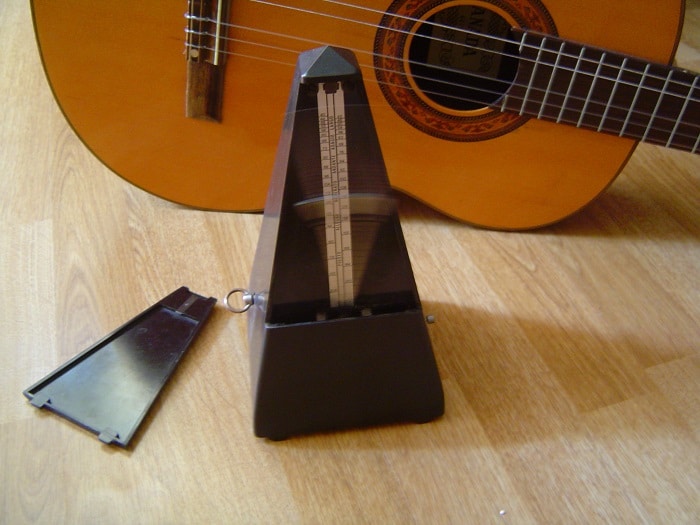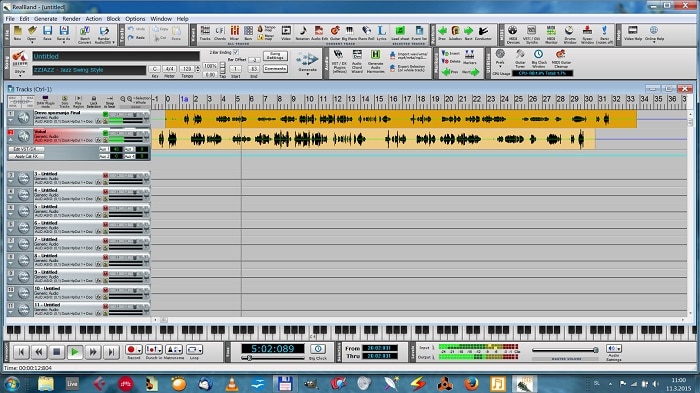A metronome is a mechanical device that provides a click sound at a selected tempo. The metronome lets you learn to control the timing of the music.
Critics of metronome practice rightfully claim that real music is not played at a strict click-click metronome tempo. In live music, the tempo gets pushed or pulled back. But, before you can push or pull the tempo, you need to establish the base rhythm is in the first place.

As a practice device, the metronome helps you establish your own “internal” timing. When you practice with your metronome tap your foot or keep the rhythm with some part of your body. You want to use your ears and get into the groove. The metronome is there to correct you if you drift.
Here’s how you can use your metronome to practice a piece of music and bring it up to tempo.
Step 1: Forget about the tempo
To begin a piece of music, you want to learn the notes without worrying about timing. Turn off the metronome and play the piece “legato” — don’t worry about playing a consistent tempo. Take as much time as needed to make the proper chord changes or note playing. Once you have the notes or changes committed to memory, get out your metronome.
Step 2: Start slowly and build from there
Set the metronome at a tempo that will let you play the piece accurately. Take into account the eighth-note phrases, or quick chord changes. You want to find a comfortable tempo, then raise it gradually.
Step 3: Find the trouble spots
You’ll likely find parts of the piece are easy, and others have you stumbling. You’re looking for those stumbling places. Without your metronome, you might unconsciously slow down at the rough spots and not realize the problems. The metronome, a relentless taskmaster, will point out the trouble spots. And, you want to find them so you can correct them (and improve your guitar playing).
Also, look for places that you can get through at tempo, but at the cost of sloppy chords or notes, fret buzzes, or other poor playing technique. It’s not just enough to play at tempo, you need to play cleanly.
Step 4: Smooth out the trouble spots
Turn off the metronome and play the two notes or the two chords of the first trouble spot. Just go through the motions slowly over and over, be conscious of the movements. Practice the changes five or six times. Then pause, shake out your hand, and repeat. Avoid getting into a pattern of mindless repetition. If you have to go painfully slow, that’s OK. As you get comfortable, bring up the tempo.
Once you’ve smoothed out that change at a moderate tempo, add the note or chord immediately ahead of that change. Practice that until those three moves are smooth, bring up the tempo (without the metronome).
Now add the note or chord immediately after the change. Practice these four changes. Keep building outward add the next note ahead of the passage, then the next note at the end.
Step 5: Repeat the process
Turn on the metronome up the tempo a bit from Step 2, and repeat the process until you’ve built up to the required tempo. Keep in mind if you’re practicing a piece that requires a blistering pace, this could take weeks, if not months. Keep identifying the new stress points at the faster tempos.
Alternatives to Hardware Metronomes
When used properly, a metronome is an essential tool for learning guitar. But you don’t have to run out and buy one just yet. If you can practice guitar near your computer there are loads of online metronomes. Just do a Web search for “online metronome.” These require that you’re connected to the Internet.
Also, there are loads of freeware metronome applications that you can download and run from your PC without having to be online. Try searching for “free metronome download.”
Band In A Box
One of my favorite learning (and just playing) resources is the Band-in-a-Box computer application. BIAB allows you to create “jam tracks” that allow you practice with an electronic band. As a metronome replacement, you can select an appropriate style of music and turn on the drums only. This creates a drum machine which works like a metronome but is much more fun. Like a metronome, you can set the tempo in beats per minute.

If you’re a Mac user, you’re lucky. Mac has Garage Band, a BIAB-like application, that comes bundled with most Mac PCs.
You can also buy electronic tuners that have built in metronomes like the Korg TM-40 Digital Tuner. If you’re in the market for an electronic tuner and plan on using a metronome, it’s convenient to have both devices in a single unit.
Next Post: How To Track Your Guitar Playing Progress for Maximum Results
Previous Post: Chart Your Guitar Practice for Ultimate Success
Return To: The Guitarist’s Guide To Purposeful Practice Main Page